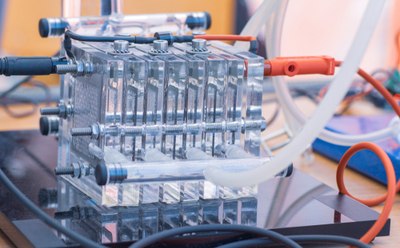Fuel Cell Membranes & Materials

As sustainable, renewable energy sources, fuel cells generate electrical energy through a reverse electrolysis reaction between a hydrogen-rich fuel source and oxygen. Fuel cells can operate higher efficiencies relative to traditional combustion engines and lower emissions, often producing only heat and water as waste products. This clean and efficient source of electricity can be scaled up for power plant applications or scaled down for transport or portable power applications. Current research is focused on improving the performance and durability of fuel cell technology while reducing costs, such as developing ion-exchange membrane electrolytes and improving membrane electrode assemblies.
Our fuel cell and membrane materials provide superior properties, such as high proton conductivity, high chemical and thermal stability, and low gas permeability for fuel cell components. We offer platinum and platinum alloys, doped-platinum catalysts, and alternative platinum-deposition materials for high activation of fuel cell catalysts.
Products
Popular Filters
Products
Solid Oxide Fuel Cells (SOFC)
Solid oxide fuel cells use a solid oxide electrolyte to conduct negative oxygen ions from the fuel cell cathode to the anode. Our solid oxide materials include a variety of yttria-stabilized zirconia (YSZ), lanthanum strontium manganite (LSM), gadolinium-doped ceria (GDC), and other ceramic materials specifically designed for improving the durability and performance of SOFC applications.
Proton Exchange Membrane (PEM) Fuel Cells
Proton Exchange Membrane (PEM) fuel cells, also referred to as Polymeric Electrolyte Membrane fuel cells, which operate at relatively low temperatures (~ 80 °C). In PEM fuel cells, a polymer membrane conducts protons from the anode to the cathode while blocking electrons, using water electrolysis to produce energy.
Fuel Cell Components
Fuel cell devices are often composed of multiple fuel cells connected in series to form a stack, which increases the total amount of generated electricity. Each individual fuel cell contains three primary components: two electrodes (anode and cathode) and a conductive electrolyte. In the case of PEM fuel cells, each electrode is comprised of a porous, high-surface area material impregnated with an electrocatalyst, typically platinum or a platinum alloy. The electrolyte material is a polymeric membrane and serves as an ionic conductor.
For fuel cells operating on pure H2, hydrogen gas is split into protons and electrons at the anode. The protons are conducted through the electrolyte membrane, and the electrons flow around the membrane, generating an electrical current. The charged ions (H+ and e-) combine with oxygen at the cathode, producing water and heat.
Fuel Cell Catalysts
Platinum exhibits high activity for hydrogen oxidation and continues to be a frequently used electrocatalyst material. One major area of fuel cell research has been the reduction in platinum content without a concurrent decrease in cell performance, giving rise to an overall increase in cost effectiveness for the device. This is achievable through the use of engineered catalysts fabricated from platinum nanoparticles supported on conductive carbon (738581, 738549, and 738557). These materials have the advantage of highly dispersed nanoparticles, high electrocatalytic surface area (ESA), and minimal particle growth at elevated temperatures, even at higher levels of Pt loading.
Pt-containing alloys are useful for devices operating on specialized fuel sources, such as methanol or reformate (H2, CO2, CO, and N2). Pt/Ru alloys, for example, have shown increased performance relative to pure Pt electrocatalysts with respect to methanol oxidation and carbon monoxide poisoning. Pt3Co is another catalyst of interest (particularly for PEMFC cathodes) and has demonstrated enhanced performance for the oxygen reduction reaction as well as high stability. Vulcan® XC72 is a mesoporous carbon black, used as a catalyst support. Its high specific surface area and excellent electrical conductivity helps improving the performance of PEMFC and in regulating the size of catalyst nanoparticles in catalysis.
Fuel Cell Membranes
Several key requirements are considered when selecting a fuel cell electrolyte. Desirable properties include high proton conductivity, high chemical and thermal stability, and low gas permeability. Aquivion® D79-25BS is a perfluorosulfonic acid (PFSA) ionomer dispersion used in the fabrication of PEM separator membranes and as a component in heterogeneous catalysts. Aquivion® D79-25BS has a very high concentration of functional groups for strong proton (or Na+, K+, Li+, etc.) conductivity, exhibits a high softening point for high-temperature operation well above 80 ºC, and demonstrates strong water retention for better fuel cell operation under low-humidity conditions for membranes or catalyst inks that utilize this dispersion material.
Related Resources
- Article: Materials for Thin Film Solid Oxide Fuel Cells (TF-SOFCs)
Thin film solid oxide fuel cells offer technical advantages; review of TF-SOFC deposition methods for electrolyte thin films.
- Article: Advances in Materials for Solid Oxide Fuel Cells
As with all types of fuel cells, a Solid Oxide Fuel Cell (SOFC) is capable of efficiently transforming chemical energy into electrical energy.
- Article: Perfluorosulfonic Acid Membranes for Fuel Cell and Electrolyser Applications
Advances in electrochemical water conversion and understanding PEMFC degradation drive progress in hydrogen technologies.
To continue reading please sign in or create an account.
Don't Have An Account?